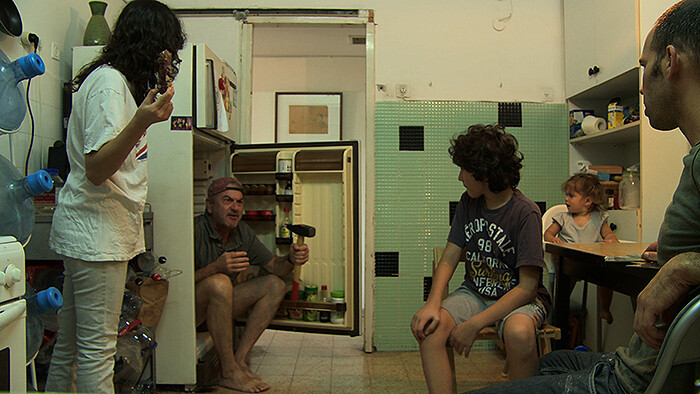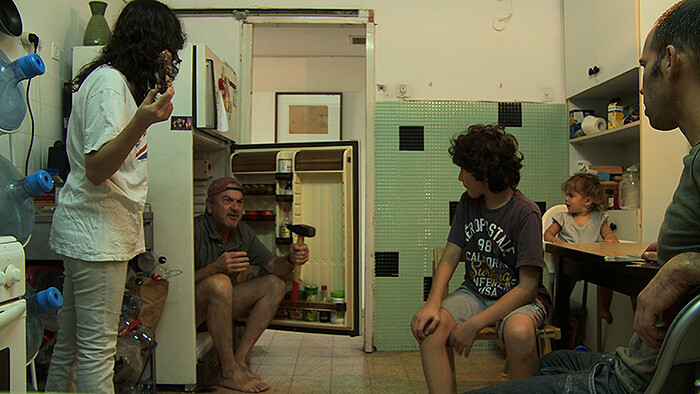In her essay on Martha Rosler’s Bringing the War Home: House Beautiful (1967–72) 1, art critic Laura Cottingham states that the infamous photomontages of Vietnam’s killing fields and American bourgeois interiors came as a reaction to frustration. Rosler couldn’t bear what she herself calls “the images [that] were always very far away, in a place we couldn’t imagine.” Cottingham writes: “Rosler reveals the artificiality of this severed causality. The separation of us from them, here from there, is an illusion we want, as a war-profit society and as immediately war-free individuals, to maintain.” In Soundtrack (2013), Guy Ben-Ner’s latest video on show in Genoa, at Pinksummer (which commissioned the work) brings the war home too. 2 It’s a fictional war, in principle—the soundtrack that gives the work its title is a “readymade” eleven-minute excerpt from Steven Spielberg’s movie War of the Worlds (2005)—while the household where Ben-Ner brings it to, is not: it’s his flat, in Tel Aviv, and the LiveLeak reportage images of attacks on Gaza that run on a computer screen, open on the table, remind us that the real wars are happening next door. A line from the movie like “Are we under attack?” or the farcical reference to Martian invaders—“What is it? Is it terrorists?” “These came from some place else.” “What do you mean, like, Europe?” “No, Robbie, not like Europe!”—elicit obvious associations with the political situation in Israel, Palestine, Lebanon, and beyond.
Ben Ner’s family is at war too: the artist’s choice of Spielberg’s movie, starring Tom Cruise as a dysfunctional father, divorced and forced to spend the weekend with his angered kids, has patent autobiographical echoes. In real life, Ben Ner has three kids, two of whom (from his ex) are now in their teenage years. So when, in the video, Ben Ner’s older daughter lip-syncs “Mom! Mom! I want mooooooom!!” it’s a moment When Worlds Collide (1951)—to quote another old, memorable Hollywood catastrophist movie—when facts and fiction overlap.
Since the early 1990s, Ben-Ner has been producing low-tech videos in collaboration with his family, as if to reaffirm that no real separation between art and life, private and public, here and there, is ever possible. Often, he shrank the plots of some great adventure novels (Moby Dick, 1851, and Robinson Crusoe, 1719, for instance) to the setting of his kitchen, in order to tell his own personal stories. In Stealing Beauty (2007), we see the Ben-Ner family making themselves at home in IKEA showrooms across Europe, as if actually inhabiting those picture-perfect living units; while for Drop the Monkey (2009), commissioned by Performa09, Ben-Ner filmed and edited in camera a seamless phone conversation with himself, while he travelled back and forth 25 times between Tel Aviv and Berlin (his family’s home and his girlfriend’s home) with the plan of making a film (and a living) out of it. Recording the collapse of his new relationship and a growing feeling of alienation, the t-shirt he wears probably sums up his state of mind most succinctly: I WISH I WAS SOMEWHERE ELSE.
Soundtrack’s mechanism is very simple, although it obviously implies a lot of patience on the part of the artist (the re-runs, the editing). Ben-Ner refers to the process as “budding,” that is, the opposite of dubbing: the original soundtrack plays on, while the artist, his children, his parents, and several friends re-enact arbitrarily the invisible scenes of the movie. In the opening sequences, they appear as DIY foley artists, using cups, rubble, balloons, and vacuum cleaners to reproduce the sounds of explosions. As the plot unfolds, they become the protagonists of a slapstick sequence of domestic calamities (a blender catches fire, plates and flour fall to the ground, and, dramatically, a single sock has to be retrieved from the laundrette), while Ben-Ner’s two-year-old daughter, hidden under a table, maintains her grin as if in a happy-go-lucky cartoon. The overall effect is both hilarious and hilariously threatening, like a mash-up of Blake Edward’s 1964 The Pink Panther and Steven Spielberg’s 1977 Close Encounters of the Third Kind.
Ben Ner’s decision to present his kitchen as an arena of conflict is a clever one, especially when it comes to violence-related clichés. Homes are the first and often most traumatized areas of strife for many individuals, the red zones where “wars of worlds” are fought daily. Repression, aggression, alienation, revolts, and mutual hysteria are the rule, no matter how much love there may be. But there’s also another poignant factor to Ben-Ner’s kitchen-sink perspective: most wars do not happen on faraway battlefields, but within the dense fabric of cities, so that civilians are routinely targeted and constitute substantial quotas of the casualties—in Gaza, as well as in Syria, the Congo, Afghanistan… By stating his position, living in the midst of a real battleground, the artist overturns all comfortable perspectives on the neutral remoteness of disasters of war.
In a droll moment of Soundtrack, Israeli documentary filmmaker Avi Mograbi makes a cameo appearance, emerging with a sledgehammer from inside the fridge. It’s a telling appearance in a larger sense: Mograbi’s self-scrutinizing movies are always set in his study or living room, and it’s from a personal, often playful perspective that he tackles his controversial subjects, like the impact of the cycle of violence triggered by the occupation on the Israeli as well as on the Palestinian side, in Avenge But One of My Two Eyes (2005), or the interlocking of their personal memories and collective heritages, as in Once I Entered a Garden (2012), made together with his Palestinian Arabic teacher and long-time friend Ali Al-Azhari. Introspection and closeness is employed here as a therapy against denial.
And if the reader will indulge me, I’d like to add a personal note. During a recent trip to Paris, I visited the exhibition “Phantom Home” by Palestinian photographer Ahlam Shibli at the Jeu de Paume. Accused of making an apology of terrorism, the museum came under attack and received violent threats for showing the series “Death” (2011–12), shot in area of Nablus and documenting how the memory of Palestinian fighters of the Second Intifada, either deceased or imprisoned, is kept alive in their families and communities. The series, Shibli says, “exhibits some of the ways in which the ones who are absent become present again—‘represented.’” I do not quote Shibli here out of a politically-correct need to balance geopolitical perspectives: what struck me, again, was the domestic focus of Shibli’s images, their reflection on how to narrate on the personal level, on the constant proximity, under the same roof, of the living (mothers, fathers, sisters, brothers) and the dead (large painted portraits, photos, photoshopped posters), and all the pain that disavowal can bring. Violence doesn’t come from Mars; there’s no way we can’t think of it as Rosler’s “very faraway” place.
Laura Cottingham, The War Is Always Home, catalog essay, October 1991, NYC; online at: www.martharosler.net/reviews/cottingham.html.
The video premiered in February at Sommer Gallery in Tel Aviv, and was subsequently presented at Aspect Ratio Gallery in Chicago.










